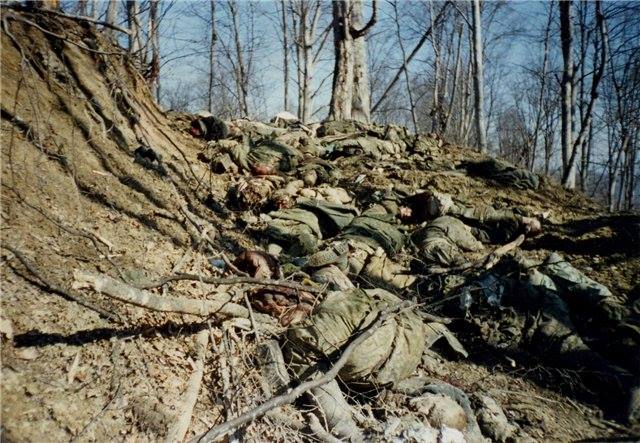How the Americans fought and how Chechens. 50-100 militants broke through to a height 776 and shot Russian soldiers from under-barrel granite launchers. The presence of body armor did not help. The American infantry could not show such a class.
https://en.wikipedia.org/wiki/Battle_for_Height_776
At dawn of 29 February, in dense fog, the Russians were surprised by a large-scale Chechen breakthrough and were attacked from their rear by a reconnaissance group of about 20 rebel fighters, soon joined by many more who then had them surrounded. After suffering heavy losses (including the death of Major Molodov) from the initial ambush, the rest of the Russians retreated to a hilltop designated Height 776, where they hastily dug defensive positions. They received fire support, including from the regimental artillery battalion's 2S9 Nona self-propelled 120 mm mortars; however, a pair ofMil Mi-24 attack helicopters reportedly turned back after being shot at en route.[8] The only Russian reinforcement that made it to Height 776 were 14 men of the 4th Company's third platoon, personally led by the battalion's deputy commander, Major Alexander Dostavalov. Attempts by the 1st and 3rd Companies, as well as the rest of the 4th Company, to rescue their surrounded comrades or to stop the breakthrough were largely unsuccessful. Eventually, badly wounded Captain Romanov allegedly called for fire support on his own position before being overrun in the final Chechen attack.According to the Russians, 84 of their soldiers were killed in combat at Height 776, including all of the officers. Only seven rank-and-file soldiers survived the battle, four of them injured[1] (some Russian sources acknowledge only six survivors, not counting the seventh who had answered a call for surrender and was then beaten, stripped out of his uniform and abandoned by the rebels[9]).
 https://en.wikipedia.org/wiki/Battle_of_Bloody_Ridge
https://en.wikipedia.org/wiki/Battle_of_Bloody_Ridge
The 36th ROK Regiment made the initial attack. It succeeded in capturing most, but not all, of the ridge after a week of fierce fighting that at times was hand to hand. It was a short-lived triumph, for the following day the North Koreans recaptured the mountain in a fierce counterattack.
The next UN assault was made by the 9th Infantry Regiment of the 2nd Division. The battle raged for ten days, as the North Koreans repulsed one assault after another by the increasingly exhausted and depleted U.S. forces. After repeatedly being driven back, the 9th succeeded in capturing one of the hill objectives after two days of heavy fighting. The weather then turned to almost constant rain, greatly slowing the attacks and making operations almost impossible because of the difficulty in bringing supplies through "rivers of mud" and up steep, slippery slopes.
Fighting continued, however, and casualties mounted. The 2nd Division's 23rd Infantry Regiment joined the attack on the main ridge while the division's other infantry regiment, the 38th Infantry Regiment, occupied positions immediately behind the main ridge which threatened to cut off any North Korean retreat. The combination of frontal attacks, flanking movements and incessant bombardment by artillery, tanks and airstrikes ultimately decided the battle. Over 14,000 artillery rounds were fired in a 24-hour period. Finally, on September 5, the North Koreans abandoned the ridge after UN forces succeeded in outflanking it.
After withdrawing from Bloody Ridge, the North Koreans set up new positions just 1,500 yards (1,400 m) away on a seven-mile (11 km) long (11 km) hill mass that was soon to earn the name Heartbreak Ridge.
The American soldiers called the piece of terrain they had taken "Bloody Ridge", which indeed it was: 2,700 UN and perhaps as many as 15,000 NK and PRC military members were casualties, almost all of them killed or wounded with few prisoners being taken by either side.The much higher NK and PRC casualties were probably caused by
1.Discipline in the KPA was poor, and constraining orders so strict to the point where subordinate leaders were often not allowed to withdraw under any conditions, in which case the entire unit would be blooded.Even when permission was granted for a withdrawal, it often came only after the large majority of troops in the unit had been killed.
2.In most battles, UN forces had an overwhelming advantage in artillery and air support; indeed, the North Korean and Chinese forces had no air support.An enormously destructive "rain of fire" could be brought by UN units against North Korean and Chinese forces which they could not answer in kind.


